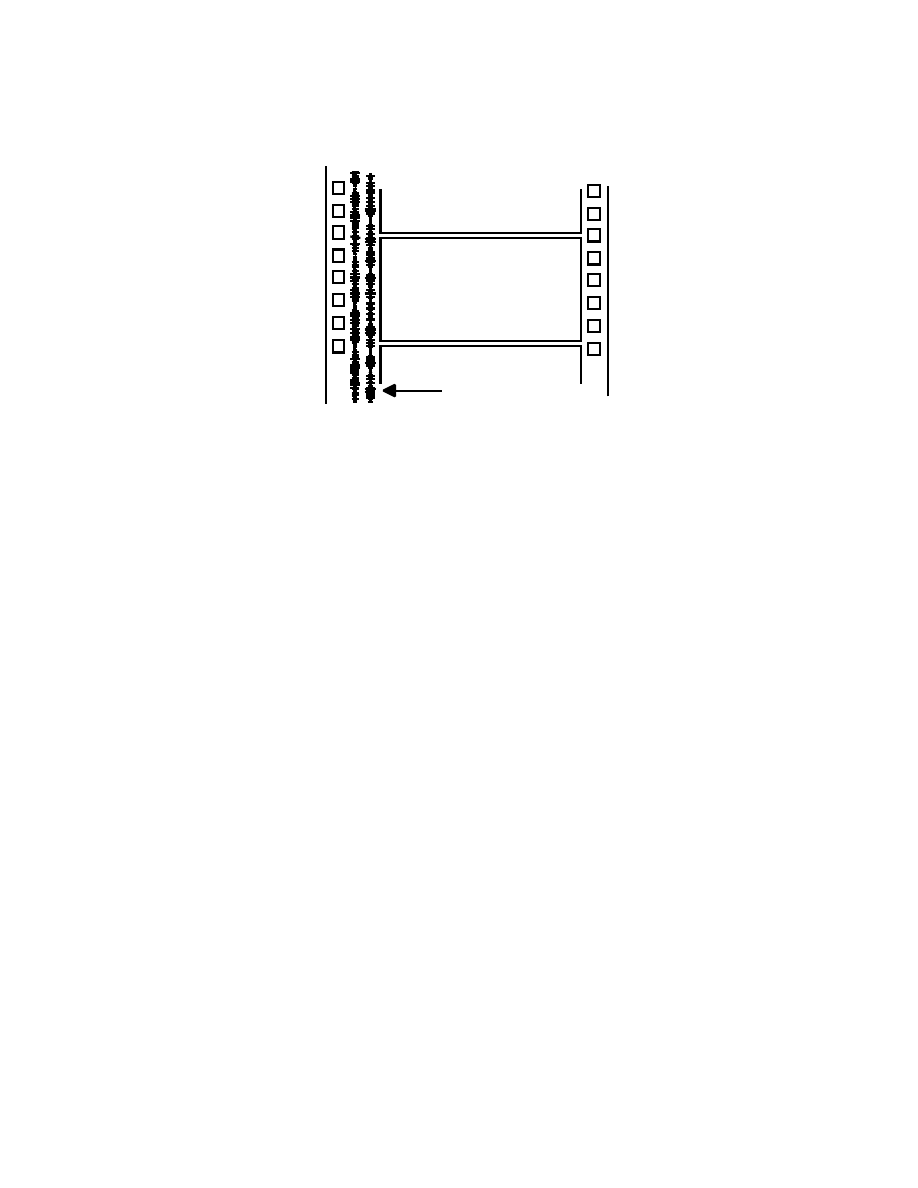ВУЗ: Казахская Национальная Академия Искусств им. Т. Жургенова
Категория: Учебное пособие
Дисциплина: Не указана
Добавлен: 03.02.2019
Просмотров: 12325
Скачиваний: 6

S
stage: (1) In an electronic device, when a signal is repeatedly amplified, any portion of the cir-
cuit in which an increase in amplification is achieved. In a mixer, for instance, there is gener-
ally a stage or buffer after each fader or pot, providing a light load to the fader and a constant
impedance to the next stage or device. (2) A dubbing stage.
stage box: See snake.
stage monitor: A wedge-shaped loudspeaker placed on the stage close to the musicians in a live
or broadcast performance. It allows them to hear the monitor mix, e.g., the bass player may
particularly need to hear the drum part.
stage sync: How well in sync the Foley or ADR is when it is recorded.
stampers: Used to press plastic CDs , the stamper is a negative copy mold made from the glass
master where the pits are reversed into spikes.
standard operating level: A reference level by which various pieces of equipment can be ad-
justed to produce identical output levels or meter readings. In professional recording, stan-
dard operating level is defined as 0VU=+4dBm. In broadcasting, 0VU=+8dBm. See line-level.
stand-by mode: See auto-input.
standing wave: An acoustical resonance in a room caused by parallel wall surfaces, also called
a room mode or an eigentone. Any set of parallel walls will establish a series of standing waves,
the lowest one of which has the wall spacing as a half-wavelength. The sound waves interfere
with one another to produce a series of places where the SPL is high and another series of
places between then where the SPL is very low, as if the sound wave were stationary between
the two surfaces. See also room mode, quarter-wavelength rule.
star network: A type of MIDI network in which a master unit is directly connected to all de-
vices in the system, instead of linking them in a serial topology. This obviates the need for
MIDI Thrus, but requires the use of a device that has a number of parallel MIDI sockets.
Start: A MIDI System real-time message which causes a device to start playing the current
song. Usually only implemented by sequencers and drum machines. See Stop.
start bit: In serial data transmission, the use of an extra bit to precede the data bits which
serves to alert the receiving device, preparing it for data to follow. See stop bit.
Start menu: The main menu in a Windows™ system, used to access applications, files, and
control panels. This is the equivalent of the Apple ( ) menu on a Mac.
static: Any dynamic, high-frequency, intermittent noise is called static. Static is distinct from
continuous noises, such as hum or buzz.
static signal processing: Signal processing in which the nature of the input signal has no ef-
fect on the type or amount of processing applied to it, as opposed to dynamic signal processing.
status byte: A MIDI message byte that defines the meaning of the data bytes that follow it.
MIDI status bytes always begin with a 1 (hex 8-F) and are numbered 128 or greater, while data
bytes always begin with a 0 (hex 0-7). The status byte determines what type of instruction is
described by the message, and is usually followed by one or more data bytes.

S
stave: Also called a staff. In notated music, the group of five horizontal lines upon and in-
between which notes are written. The lines and spaces represent increasing pitch from bottom
to top. The precise correspondence between line and pitch is determined by the clef which is
found at the beginning of every stave. The stave will occasionally have short leger lines added
above or below when needed for notes that fall outside of the range of the stave. It is common
to group staves of simultaneous parts into a score by joining them with a vertical line at the left
edge of the page and often by linking their bar lines.
steering: See Dolby Motion Picture 4:2:4.
stem: Usually used to indicate the inputs to the final mixdown, being comprised of the DME
tracks. By inference, the many individual tracks which create each of the dialog, music, and ef-
fects portions of the soundtrack would be leaves(?), and the final, mixed and edited DME in-
puts for each soundtrack are the stems.
step input: A method of loading events (such as notes) into a sequencer’s memory one event
at a time. Common step values are sixteenth- and eighth-notes. After each entry, the SPP will
advance one step then stop, awaiting new input, as opposed to recording while the clock is
running, called real-time input. Also called event editing, step recording, step-mode, and step-time.
step recording: See step input.
step-time: See step input.
stereo bar: A mounting for a pair of microphones on a single microphone stand.
stereoizing: Audio signal processing to turn a track recorded in mono into a realistic stereo
field. In an analog world, stereoizing is accomplished by remixing the mono track with a copy
of itself, and panning the output channels hard left and hard right, with slightly different EQ
on each channel to widen the image. In a digital environment, it is typically accomplished by
overdubbing the mono channel with a copy of itself, and running each channel through a re-
verb, each set with a slightly different delay. In the analog case, this results in only a slight
improvement in spreading the stereo image; with DSP, it is possible to use complicated combi-
nation of reverb and other psychoacoustic effects to get a fairly realistic stereo image. See also
double-tracking.
stereo link switch: A control on a dual-channel compressor or other effects device that sums
the side-chain inputs together, then controls both channels from the same side-chain. This is to
ensure that both channels of a stereo signal are subjected to exactly the same amount of gain
reduction or other processing so as not to shift the stereo image.
stereo optical print: There are two tracks on 35mm stereo optical prints, referred to as Lt –Rt,
on which are matrixed four channels of information. The 4:2 encoding is done during the print
mastering, with the 2:4 decoding occurring at playback (at the theater). All of the stereo optical
prints: Dolby Stereo (A-Type), Dolby-SR, DTS Stereo, and Ultra-Stereo occupy the same area
as standard mono optical prints. The degree of mono compatibility is mix-dependent.

S
Optical
Sound Track
35mm Stereo
stereophonic: From the Greek meaning “solid sound,” referring to the construction of believ-
able, solid, stable sound images. This has come to mean any sound system with two loud-
speakers. However, it precisely refers to a sound system which provides the listener with an
illusion of directional realism, regardless of how many channels are used. For example, the use
of a reverberation effect with strong early reflections and a fairly fast decay are an effective way of
creating a wide stereo spread from a mono source, such as a voice or instrument which has been
recorded with a single microphone.
stereo spread: Most two-channel stereo recordings are recorded and mixed to produce an im-
pression of diffusion and spread of the sound between the loudspeakers, where the use of arti-
ficial pan and reverberation produces a pleasing, spacious sound. However, this is not the
same as accurate, multichannel imaging.
stereo variable area: See SVA.
stereo X-Y pair: See X-Y pair.
sticky shed syndrome: A problem affecting some types of analog tape where, after a long
time in storage, the binder breaks down, causing the oxide to shed. The tape will then start to
adhere to the tape heads and guides when played. The usual short-term cure for this is to
bake the tape for several hours at 120˚F (50˚C). The long-term cure is to make a new copy as
the tape is replayed.
stinger: In a musical score, a short, accented chord played to underscore a specific dramatic
event on-screen. See hits.
STL: Studio-to-Transmitter Link. A broadcast link used to carry audio/video back to the sta-
tion from a remote site, while the studio personnel is listening off-air. Problematic because of
the transmission delays between source and return. See also OBU.
stock arrangement: A commercially published arrangement of a song, not a custom-written
piece of music or mix.

S
stomp box: A floor unit effects processor with built-in footswitches, meant to be patched be-
tween a guitar an amplifier.
stop: A lever or similar control that brings into play a particular timbre on organs and harpsi-
chords. See drawbar, registration.
Stop: A MIDI System real-time message which will cause a MIDI device to stop playing the
current song. Usually only implemented by drum machines and sequencers. See Start.
stopband: The frequency band which is not passed by a filter, as opposed to the passband. A
filter can have more than one stopband, for example a bandpass filter.
stop bit: In serial data transmission, the use of an extra bit to follow the data bits which serves
to alert the receiving device that the flow of data has stopped. See start bit.
straight transfer: See transfer.
streaming: Transfer of audio or video data in a way that enables multimedia content to be ex-
perienced in real-time rather than requiring the entire file to download first.
stress bridge: A small capsule within a breath controller that functions as a tiny potentiometer
and produces a varying voltage that is then converted into a MIDI data stream.
stretched: A descriptive term for an encoded signal, as in a NR system. Sometimes used to de-
scribe the signal after subsequent decoding. In film, a stretched transfer involved making a
new recording of an encoded recording without decoding, and then re-encoding the material.
In this way, a stretched transfer retains the original noise reduction encoding level. It is not
recommended to do the transfer on a decoded version because any response error is multi-
plied by the compression ratio, typically 2:1, of the noise reduction system.
strike: To take down or disassemble a set used in a motion picture, video, or musical per-
formance.
stringendo: Italian for “gradually becoming faster and with increasing tension.”
stripe: (1) (verb) To record timecode on a blank track of audio tape or video tape or magnetic
film. (2) (noun) A timecode and video black written to a video tape before any audio or video in-
formation is written. (3) SMPTE timecode written to unexposed mag film where a frame in the
leader is arbitrarily chosen to be 00:00:00:00. Information about reel number, etc., is contained
in the user bits data area. If the timecode is recorded before any other signals go on the tape,
the procedure is known as prestriping. Short for single-stripe.
striped: Magnetic film with one or more stripes of oxide applied longitudinally on the film
base. Typically, a “striped” tape refers to a tape which contains only a timecode track. See
striping; also film soundtrack, single-stripe.
striping: (1) The process of recording timecode onto a blank tape track. (2) Recording sync
sound from the edited video master onto an external sync recorder, usually to build music and
effects tracks, add narration, loop or post-dub some or all of the dialogue, etc. When all the re-
sulting tracks have been re-mixed, the mix is then re-layed or post-striped onto the video master,
hopefully still in sync.

S
striping off: Copying a track from a multitrack master, usually to single-stripe 35mm mag film
to facilitate editing. See regroup and layback.
stylus: The needle mounted in a cartridge on the tone arm of a turntable. It tracks the groove
of a vinyl record and its vibrations are converted, by the transducer in the cartridge, into an
audio signal.
sub-band coding: A type of the split-band coding process, where the incoming audio signal is
split into a number of independent frequency sub-bands, and the accuracy of the quantization is
varied in each band according to the input signal energy. Critical regions of the audio spec-
trum can, therefore, be coded more accurately, with quantizing energy being biased toward
the high-sensitivity, low-frequency regions. High-energy regions are also coded more accu-
rately than in PCM techniques, yielding a lower coding noise platform. See transform coding.
sub bass: Frequencies which are lower than the range of the monitors in use, or below the
range that a typical monitor can reproduce with fidelity. Sub base is different from infrasonic
in that the former applies to the reproduction of low-frequency audio, while the latter refers to
the AF range itself. In practice, the two terms are often used interchangeably.
subcode: In digital audio systems, particularly CD and R-DAT, additional data interleaved
with the audio information which carries synchronization and user information, such as tags
and comments which is independent from the audio data. The three main types of DAT sub-
codes are Start IDs which mark the beginning of each song, Program Numbers which are the
ordinal numbers assigned to each Start ID, and Skip IDs which causes a player to not play the
selection whose number is the current Start ID and go to the next Start ID. See also PQ Codes.
subframe: In SMPTE timecode synchronization, a unit of time smaller than a frame, generally
1
100
th of a frame in length. Synchronizers are designed to maintain synchronization to within a
small number of subframes. See frame sync, phase sync.
subharmonic: A harmonic lower in frequency than the fundamental. Sometimes subharmonics
are produced by loudspeakers that have poorly controlled cone resonances. The audible effect
is a distortion component one octave lower than the input signal frequency.
Sub ID#1, Sub ID#2: In MIDI, two data bytes which follow a Universal System-Exclusive
data byte in a system-exclusive message which define the type of message. A Sub ID#1 value of
1 indicates MTC and bay be followed by a Sub ID#2 value of 1 for a Full Message, or 2 (User
Bits), or 15 (Set-Up). A Universal non-real-time Sub ID#1 value of 5, on the other hand, indi-
cates a sample dump and may be followed by a Sub ID#2 value of 1 for a Multiple Loop Points
message or 2 for a Loop Points Request.
subito: Italian for “suddenly,” as in subito ƒ, suddenly loud.
submaster: (1) A control on a mixer that controls the level of a group of signals, sometimes
called a group master. Several submasters may be fed into a master control for final level con-
trol of the console output signal. The use of submasters makes it easier to handle a large num-
ber of input signals. See gang. (2) Any tape used in the making of a master tape, but repre-
senting an earlier generation number of some or all of the material included in the final master.